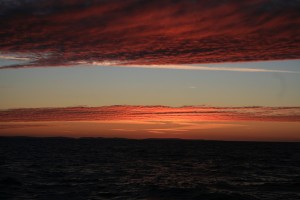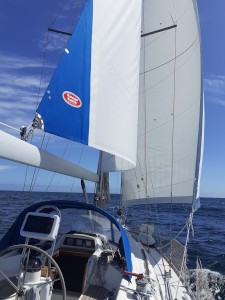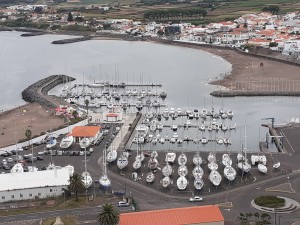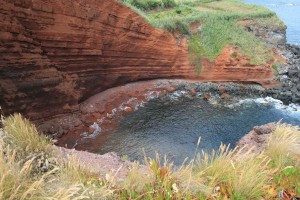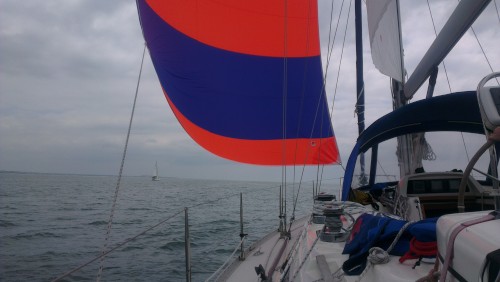Grown Ups Gap Year
Now the girls have finished University it is our turn for a gap year! #grownupsgapyear
| Vessel Name: | Mirage |
| Vessel Make/Model: | Moody 38CC - 1993 |
| Hailing Port: | Poole, Dorset, UK |
| Crew: | Sally and Paul |
| Extra: | After the girls had finished university we decided it is our turn for a gap year. |
04 August 2020
Falmouth to Studland
We spent two nights on a mooring buoy in Falmouth but wished we could have stayed longer and had a slow passage home to Poole. However we are getting Mirage lifted out of the water as soon as practicable and we do this near to where we live. To get to the boat yard we have to go up the local river that [...]
02 August 2020
Azores to Falmouth - the arrival
With the final 400 NM we were typically doing 140 NM a day or better until the last night on the way to Lizard Point and the entry to Falmouth. The wind was around 20 knots for most of the time but the wave grew bigger during the first 200NM and became steeper once we had crossed the continental shelf. These [...]
29 July 2020 | Atlantic Ocean
Azores to Falmouth Update 2
Day 4 brought the strong winds we had been expecting but we had kept ourselves further south than the shortest route to help keep out the strongest. The day was a mix of drizzle and sunshine but still warm enough to keep the shorts on & we carried on sailing at a good pace crossing the 800NM to go [...]
25 July 2020 | Atlantic Ocean
Azores to Falmouth Update
We left just after 10am on Wed 23rd to sail the 1156NM to Falmouth. The weather did its best to give us a good send off but the wind was missing! We were waved goodbye by the boats from Praia do Vitoria and help with our lines by some friends we had met there. With the lack of wind we needed to motor [...]
22 July 2020
Terceira
We did an overnight sail to Terceira Island (Ilha Terceira) from Sao Jorge to ensure we arrived in the daylight. Our destination was the marina at Praia da Vitória. This is known to be the cheapest in the Azores but is also a good departure place from the Azores to the UK. The sail took us initially [...]
15 July 2020
São Jorge
We left Horta for São Jorge at 08:30 to sail the 22NM. We knew it was going to be a slow sail as the wind was light and we also only had the genoa which when on its own isn't the ideal sail for an upwind sail. With her clean bottom however Mirage didn't disgrace herself and we managed the sail in just [...]
Dominica - The Nature Island

We sailed to Roseau, located on the south western end of the island, with Palatina and whoever arrived was to ask for two adjacent mooring buoys and arrange to talk about the trip to Boiling Lake for the whole group. The 35NM sail was a nice sail with the wind on the beam which is the best sailing angle for Mirage and were had a very fast passage between the islands. As usual we still didn't have any luck with the fishing line but I suspect a lot of that was again down to sailing too fast and not having the lure deep enough. We made Dominica at Scott's Head and could see Roseau and the anchorage in the distance however the pace now dramatically slowed as we came into the lee of the island and with speeds as low as 2 knots it seemed very pedestrian. We arrived slightly in front of Palatina and secured the two mooring buoys through Sea Cat Tours and arranged for a group discussion later on that afternoon. With Palatinas arrival we all headed ashore to clear customs, an easy and friendly task and as we were staying less than 14 days we were able to clear in and clear out at the same time. This is the first island that sensibly runs this practice as it saves bureaucracy and their officials time. The customs office was in the ferry terminal and fortunately by the time we arrived that days cruise liner had cleared in for and we didn't have to wait. After a quick look around frontage of Roseau, an initial very favourable introduction, we headed back to Mirage to raise the Dominica courtesy flag. The flag is one of only two national flags containing the colour purple (the other being Nicaragua) as it features the Sisserou parrot, also known as the imperial amazon and found only on Dominica. The Sisserou Parrot is the island's national bird and sits in the middle of the national flag. We were only staying four nights in Roseau but had three very busy days planned.
With the arrival of Mr Bean (not Rowan Atkinson) from Sea Cat Tours on Palatina we arranged the guided tour to Boiling Lake the following day for the 5 of us. This necessitated a 6:30AM pick up from the boat so it was an early night for every one. The hike to Boiling Lake is at least a 7 hour return hike starting in the Tropical Forest, through the Elfin Forest and then up to the top of the volcano. We were picked up by water taxi dead on 6:30AM by Mr Bean, as arranged, and dropped off at the jetty by Sea Cat's mini-bus ready for the 45 minutes drive to the start of the climb. The drive took us though Roseau and passing one of the new Hydro generation plants as Dominica has the stated aim of obtaining all its power generation using renewable energy including solar and geothermal energy but the hurricane in 2017 has had a slow down on the progress for obvious reasons. The drive to the start of our hike gave us an introduction to the true Dominica with a running commentary by Sea Cat.
The walk started at the visitors centre and was just over a 8 mile (13 km) return hike and as the photos show the gradient was very extreme in places requiring rope to pull you up. The first stage started in Laudat, by Titou Gorge and ended at Breakfast River, where we filled up with fresh water. Usually this is used for a breakfast stop hence its name however we were running slightly behind schedule as one of the older walkers was struggling. The second part continued up Morne Nicholls to an altitude of just under 1000m above sea level. This is also at the top of the Valley of Desolation and we were treated to a fruit cocktail drink that Sea Cat had carried up starting as a frozen block. The final part starts with a very steep descent into the Valley of Desolation, followed by a long hike past sulphur springs and hot pools, until finally reaching a cliff-top ledge about 100 feet (30 m) directly above the shore and over looking boiling lake.
Whilst we were walking Sea Cat gave us a details of the flora and fauna and how the tropical forest had significantly changed since the hurricane. The 2017 hurricane had stripped the top branches from the majority of the tallest trees which has in turn allowed more light to the floor of the forest which had in turn allowed many more shrubs and smaller plants to grow. The fruit used by the bird life has also significantly diminished so the islands parrots were no longer a regular sight in this area of the island. The first part of the hike was in tropical rain forest but as we climbed the forest changed to the Elphin forest, so called as the height of the trees reduced to the much higher daily wind strength. The hike was a mixture of muddy paths, rock scrambling and crossing rivers but aided throughout by logs and stones placed on the path. At some places steps had been chiselled into rock again to help.
Boiling Lake is at the bottom of a large sinkhole-like basin. More accurately, as we were told it is a flooded fumarole, which emits steam and gases escaping from molten magma below. Currently, the lake is viewed from a broad, cliff-top ledge about 100 feet (30 m) directly above its shore. High rock walls surround and create the basin. The level of the lake rises and falls at different times and sometimes the Boiling Lake even stops to boil, but fortunately for hikers this is very rare. The Lake is kept topped up by a small waterfall feeding in water along with the many frequent rain showers. We had a couple of very heavy showers during the hike but always dried quickly afterwards. On the way up as we went through the sulphur springs Sea Cat magically produced some eggs and promptly boiled them giving us all a nice freshly boiled egg. The mud in the sulphur springs is very good for your skin and we all had a lovely free mud face pack that we kept on as we continued our walk to the lake as the photos show. We had lunch overlooking Boiling Lake, all prepared by Sea Cat from local fruits and vegetables as well as twice boiled salted fish. As we headed back down we stopped at one of the warm waterfall fed pools and were treated to a nice warm bath to ease our muscles and wash our faces removing any remains of the face pack. At the end of the walk we ended in the, now open bar, at Laudat visitors centre for a celebratory drink before being driven back to the boat. We defiantly ached after the walk and needed plenty of stretching of muscles. We had an early night as we had yet more busy plans for the following day.
Using local buses and walking our three Dutch friends and us visited both Scotts Head and Champagne bay at the extreme southern end of Dominica. Scotts Head is a fishing village that overlooks Soufrière Bay, and has the Caribbean's only tied island that looks similar in shape to Portland, albeit much smaller. The island shares it's name with the village just to confuse. The original Carib name of the peninsula is Cachacrou, literally a "hat which is being eaten". The island is part of the top of an extinct volcano that has collapsed into the water. We walked to the top of the island, unsurprisingly part of an old fort, to explore. Scotts Head was named after Colonel George Scott, who had served in the British invasion force that captured Dominica from the French in 1761 and then became lieutenant governor of Dominica from 1764 to 1767. Scott oversaw the construction of a fort on the headland of the Scotts Head peninsula. The information boards stated that the bulk of this fortification has collapsed down the cliff into the water, though some ruins remain, including a small cannon. After the walk to the remains of the fort we descended to the beach and having all brought our snorkelling gear went for a swim. This beach is very popular for diving as about 50m from the beach you literally swim over the remains of the volcano and the bottom disappears into the darkness. The actual depth is unknown and even modern depth sounders have not reached the bottom. This area is a marine nature park and the sheer quantity and variety of fish does the management of this area proud and the feeling of swimmiong over the volcano was immense. After a quick walk back to the village and a short bus ride we arrived at Champagne Bay.
Champagne Bay is so called as the area you swim in has an almost contentious release of bubbles into the sea from geothermal activity below the surface and again the snorkelling was superb amongst a large number and varieties of fish. There were a significant number of very large parrot fish in the area, many more than we have previously seen. After our swim it was a 40 minute walk back to the dinghy via a bar and a cold drink.
Our final day in Roseau was spent visiting Middleham Falls. These falls, with around 260 foot drop, are regarded at the best on the island and are the tallest in the Caribbean. We travelled to the starting point of the hike using local buses and as we hiked to the falls we passed a group of, mainly British, passengers from the P&O Ventura Cruise liner that had arrived that morning in Roseau. They were on a 35 day cruise starting and ending in Southampton and doing a very similar route to us. Many were amazed when we mentioned we were doing a similar trip but in a 38 foot sailing yacht. From the information given to us by Sea Cat we had a greater understanding of the forest during the walk to the waterfall. The trail started with a gradual incline again with the wooden logs as Boiling Lake had and had several twists and turns, ups and downs but climbing overall. The route was very muddy and the rain didn't do anything to help reduce this but it is the rain forest after all! We crossed several small streams, easily done as there were boulders and rocks to help but care was needed on the slippery surfaces and also had several rock scrambles during the hike. After about an hour we arrived at a staircase that we descended to a viewing platform looking across and up the waterfall. We had all brought our swimming stuff but in the end only I was stupid enough to swim in the cold water! It was a challenge to get to the pool at the bottom of the fall as the rocks were wet and very slippery but the very refreshing swim in the waterfall lived up to my expectations and the weight of the water cascading on to me was amazing. The Middleham falls were busier than we had expected and we hadn't really expected to see the cruise liner passenger due to their usual time constraints but it was by far the best waterfall seen on this trip. We caught a bus but got off early in Roseau to have a late packed lunch in the botanical gardens before heading home to Mirage to prepare for our sailing the following day.
Again we sailed with Palatina from Roseau to Portsmouth along the west coast of Dominica and after the busy time at Roseau it was nice to have a day off from hiking! These are only two places on Dominica that yachts are allowed to stay and the second is Prince Rupert Bay with the town of Portsmouth. The moorings and one of the anchorages are managed by PAYS (Portsmouth Association of Yacht Security and Services). PAYS is a co-operative of 'boat boys' etc. that provide the services in the bay and require their members to have a certain level of training. Additionally they provide security as historically Dominica suffered with petty crime aimed at the cruising community. We were looking forward to catching up with our friends Tracy and Richard on Zephyr who had already sailed to Prince Rupert Bay.
Tracy and Richard didn't want us to get to lazy and the following day we walked to the Cabrits National Park overlooking the Bay. Cabrits National Park is on a peninsula at the north end of the Bay, north of Portsmouth. The park protects tropical forest, coral reefs and wetlands. There are hiking trails that gave us great views on the Bay but also across to Guadalupe and beyond. Cabrits is an extinct volcano that was once a separate island from mainland Dominica but became connected to Dominica by the current sweeping material in from Douglas Bay and Prince Rupert Bay. The word Cabrits is derived from "goat" in Spanish, French and Portuguese. Goats were introduced to the island by sailors, who set them free on the island to grow, so that there would be meat available when they ever returned. Cabrits was also home to Fort Shirley. The British began building it in 1765 as a garrison to defend north Dominica and it was extended by the French during their occupation of Dominica from 1778 to 1784. It consisted of over 50 buildings, and housed over 600 men but was finally abandoned in 1854. Dr. Lennox Honychurch began restoration in 1982 aided by funding from the Canadians and the main entrance area is completely restored. However while walking around the trails we found ruins scattered around including the Commandants House. BAYS run a wkly Sunday BBQ and we were all attending, starting at 7PM we had a great chicken BBQ with a garlic rice dish and salad as well as much as you could drink of either fruit cocktail, or rum punch. This was followed by dancing to reggae played by one the PAYS members and a very impressive sound system. I think nearly every boat in the bay attended and was an immensely fun evening chatting to both the PAYS guys and the other boat crews at the party. Dancing to a Reggae style Macarena is something not to be forgotten.
After a day off doing boat chores, filling up with water, arranging a taxi for the following day we ended the day having a lovely evening meal with Tracy and Richard on board Mirage where we finally persuaded them that they really should go back to Roseau to do both Boiling Lake and Middleham Falls.
The taxi we had arranged was to take us to the Syndicate Nature trail where we could also walk section 11 of Waitukubuli Trail. The Waitukubuli Trail is the longest hiking trail in the Caribbean at 115 miles and is made of 14 segments, beginning in the southern village of Scott's Head, and ending in the north at Cabrit's National Park. The trail was officially opened in 2013 and was named after the original Kalinago name of the island, Waitukubuli, meaning "tall is her body". The nature trail is one of the few places that the two parrots that live in Dominica can be seen and fortunately we saw then right at the beginning of the hike as well as during it. The hike took just over 4 hours and we ended back in Portsmouth. The walk started very flat and was along a well maintained route with the occasional fallen tree that needed to be climbed over, most likely as a result of the hurricane. Dominica has two varieties of snake and we were amazed that we saw one of each on our walk. The first we saw was a Boa Constrictor that all most made Richard jump out of his skin as it was almost 2m long and perfectly blended in to the leaf litter it was hidden in. The second, but much smaller, was the Blunt-Headed Tree Snake even though we found it basking in the sun on the ground. This was quite a small snake as they can grow to over 0.5m long. Fortunately there are no poisonous snakes on Dominica! As this was tropical rain forest we were walking though it was very similar to the early parts of the Boiling Lake walk and we recognised some the plants including the aptly named lobster claw with it flower in bloom showing why it gets it name. The final part of the walk was a very steep descent in to a valley that helpfully had rope hand rails tied up in several places which brought us down to a river complete with a very rickety locking bridge that had seen better days. The walk was yet another great day out with friends allowing us to see some of Dominica at it best.
Our final day in Dominica was spent on Mirage doing various chores that we have been meaning to do but just been too busy including some bread making but we also managed to fit in a snorkel. The water around Dominica drops in depth very quickly, especially out of the bay, so the quantity of fish was not as great as other places we have swum. We also had visitors, Julie and Tim from Whisper, we first met in Barbados from the East of the UK who had come for Christmas dinner as they arrived in to the anchorage during the afternoon.
We have loved our time in Dominica and the people have been friendly and welcoming and the pride is very evident in their island. They took a battering when they were directly hit by a category 5 hurricane,
Hurricane Maria in 2017 when the eye crossed the island but their strength of character has defiantly helped with the redevelopment of the island.
